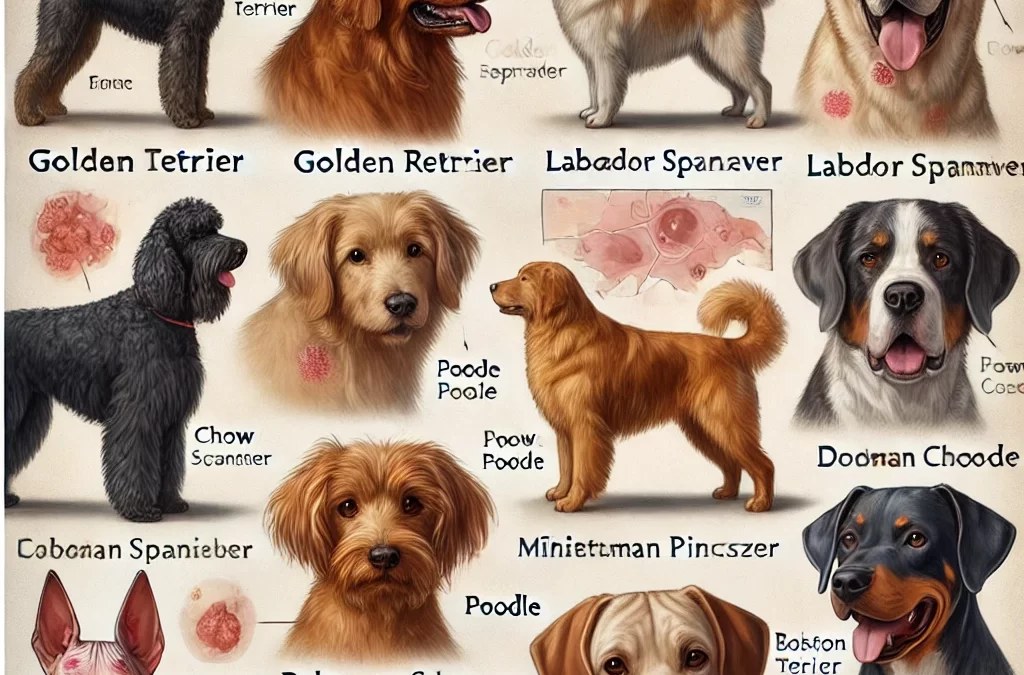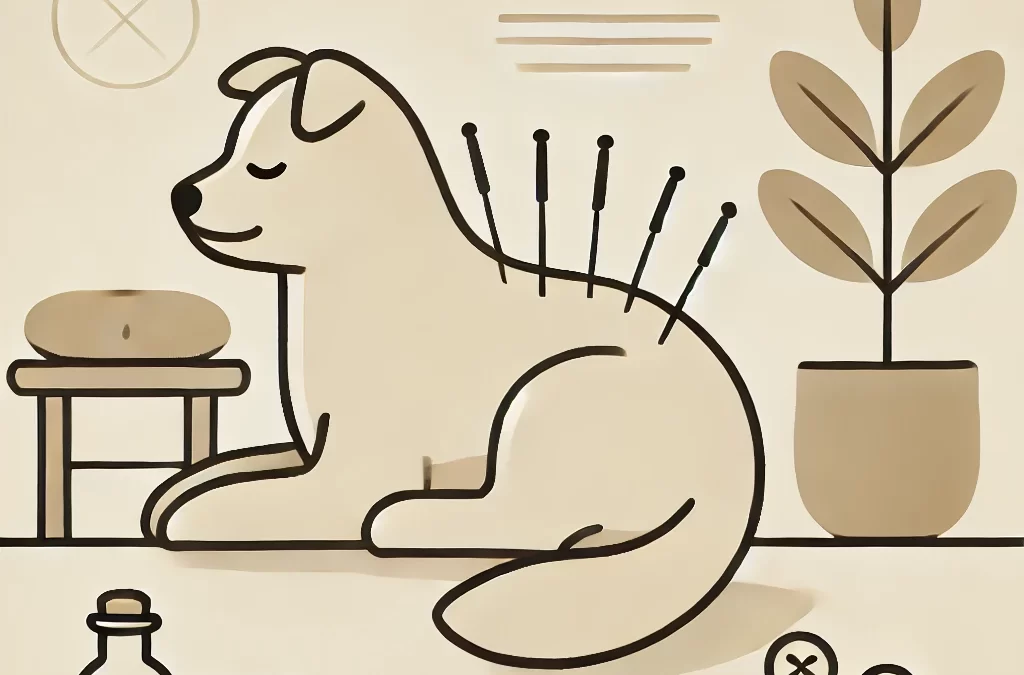
經過 TCMVET | 2025年2月6日 | 狗癌症和腫瘤
癌症越來越受到寵物主人的關注,特別是那些擁有多隻狗的寵物主人。當家裡的一隻狗被診斷出罹患癌症時,人們通常會問一個問題: 犬癌症會傳染嗎? 了解癌症的性質及其擴散方式可以幫助寵物主人採取適當的預防措施,同時為他們毛茸茸的伙伴提供最好的護理。
狗狗癌症會傳染嗎?
簡單的答案是 不—狗的大多數癌症形式是 無傳染性。與病毒或細菌引起的傳染病不同,癌症是指人體內異常細胞不受控制的生長。它不會透過直接接觸、共用食盆或近距離從一隻狗傳播到另一隻狗。
然而, 罕見的例外, 例如 傳染性性病腫瘤(TVT),它可以透過直接接觸傳播,尤其是在交配過程中。 TVT 是狗身上唯一自然發生的傳染性癌症之一,主要影響流浪狗或未絕育的狗。除此之外,淋巴瘤、骨肉瘤和肥大細胞瘤等常規癌症不會在狗之間傳播。
癌症會受到環境因素的影響嗎?
雖然癌症本身不具傳染性,但生活在同一個家庭的狗可能會感染 常見的環境風險 這可能會導致癌症的發展。這些包括:
- 接觸二手煙 – 吸菸家庭中的狗狗罹患肺癌和鼻腔腫瘤的風險更高。
- 有毒化學品 – 殺蟲劑、除草劑和家用清潔產品可能會增加寵物罹患癌症的風險。
- 飲食與肥胖 – 不良的飲食和肥胖相關的發炎會隨著時間的推移而導致癌症的發展。
- Genetics – 如果一個家庭中的多隻狗來自同一血統或品種,它們可能具有某些癌症的遺傳易感性。
養多隻狗的主人該怎麼做?
即使癌症不具傳染性,寵物主人也應採取某些預防措施,以確保所有狗的健康和福祉:
1. 保持健康的環境
- 保持家中沒有有害毒素,包括香菸煙霧和刺激性化學物質。
- 避免在狗狗玩耍的地方使用殺蟲劑和除草劑。
2. 支持營養飲食
- 用新鮮、天然的食材餵食所有的狗狗均衡、高品質的飲食。
- 考慮支持免疫健康的補充劑,例如 Omega-3 脂肪酸和抗氧化劑。
3. 監測其他狗的症狀
- 定期檢查是否有腫塊、腫脹、體重減輕或行為變化。
- 安排年度獸醫檢查和常規癌症篩檢,特別是針對老年犬或容易罹患癌症的品種。
4.提供情感支持
- 如果一隻狗被診斷出罹患癌症,家裡的其他狗可能會經歷壓力或行為變化。
- 保持穩定的日常生活規律並為家中的所有寵物提供舒適的環境。
5. 諮詢獸醫
- 如果您擔心家中有癌症風險,請諮詢您的獸醫,以取得預防和早期發現的個人化建議。
結論
犬癌症不具傳染性,但共同的環境因素和遺傳傾向可能會影響家庭中多隻狗的癌症風險。透過維持健康的居家環境、提供適當的營養以及保持對症狀的警惕,寵物主人可以幫助他們的狗活得更長、更健康。如果您的一隻狗被診斷出患有癌症,那麼提供愛、安慰和適當的醫療護理是支持它的最佳方式,同時確保整個狗群的健康。

經過 TCMVET | 2025 年 1 月 26 日 | 狗癌症和腫瘤
骨肉瘤 (OSA) 是犬類中最常見的原發性骨癌,尤其影響大型犬種。由於其侵襲性和快速轉移,這種癌症給寵物主人帶來了巨大的挑戰。然而,了解風險因素並採取預防策略可以發揮作用。本文探討了為什麼大型犬更容易患骨肉瘤,以及主人可以採取哪些積極措施來最大程度地降低風險。
為什麼大型和巨型品種更容易患骨肉瘤?
- 快速生長和骨骼發育
大型犬和巨型犬在出生後的最初幾個月生長迅速,給它們的骨骼帶來壓力。這種快速生長可能會導致骨骼結構的微小損傷,從而產生癌性突變的傾向。
- 遺傳因素
某些品種具有骨肉瘤的遺傳傾向。常見受影響的品種包括:- 大丹犬
- 聖伯納犬
- 愛爾蘭獵狼犬
- 羅威納犬
- 灰狗
- 拉布拉多獵犬
- 黃金獵犬
- 肢體長度和骨應力
四肢較長的較高的狗更容易受到骨骼壓力。骨肉瘤常發生在橈骨、尺骨、肱骨和股骨等負重骨。
- 荷爾蒙的影響和絕育/絕育
研究表明,早期絕育,特別是在骨骼成熟之前,可能會增加骨肉瘤的風險。這被認為與性荷爾蒙的去除有關,性荷爾蒙在骨骼生長調節中發揮作用。
- 慢性發炎和骨骼創傷
反覆外傷、既往骨折或骨科手術可能會增加狗的癌症易感性,尤其是已經容易患骨肉瘤的品種。
如何降低大型犬患骨肉瘤的風險
- 幼犬時期的受控生長
- 避免高熱量、快速生長的飲食,這會對正在發育的骨骼造成過度的壓力。
- 給大型幼犬餵食特殊配方的食物,以促進穩定、受控的生長。
- 均衡飲食與抗氧化劑
- 加入富含 omega-3 脂肪酸、薑黃和抗氧化劑 對抗炎症和氧化壓力。
- 控制鈣和磷水平的飲食有助於骨骼健康而不會過度生長。
- 負責任的絕育
- 考慮延後絕育,直到狗的骨骼成熟為止(大型犬種通常需要 18-24 個月左右)。
- 與獸醫討論替代絕育方案,以平衡癌症風險與生殖健康。
- 定期鍛煉,不要過度勞累
- 游泳和有控制的步行等低影響活動有助於保持骨骼和關節健康。
- 避免過度跳躍和重複的高強度活動,尤其是幼犬。
- 早期發現和常規檢查
- 定期的獸醫檢查有助於及早發現細微的骨骼變化。
- 業主應留意以下跡象: 跛行、四肢腫脹、持續疼痛或突然活動困難。
- 骨骼強度補充劑
- 葡萄糖胺和軟骨素: 支持關節和骨骼的完整性。
- 維生素 D 和 K2: 有助於鈣的吸收和骨密度。
- 薑黃素和藥用蘑菇: 具有抗炎和潛在的抗癌特性。
- 避免環境毒素
- 減少接觸已知致癌物,包括殺蟲劑、菸草煙霧和含有人工添加物的加工寵物食品。
最後的想法
雖然大型犬和巨型犬患骨肉瘤的風險較高,但預防性護理可以在減少這種威脅方面發揮重要作用。均衡飲食、控制運動、負責任的飼養和定期健康監測可以幫助寵物主人有效管理風險。積極主動不僅可以延長狗的壽命,還可以提高它們的整體生活品質。如果您發現任何跛行或腫脹的跡象,請諮詢獸醫,因為早期診斷對於改善結果至關重要。

經過 TCMVET | 2025 年 1 月 26 日 | 狗癌症和腫瘤
黑色素瘤是狗狗最受關注的癌症之一,通常出現在口腔、皮膚、甲床,甚至眼睛。雖然所有的狗都可能患上黑色素瘤,但某些品種的狗由於色素沉著、皮膚特徵和其他生物因素而具有遺傳傾向。本文探討了哪些犬種更容易罹患黑色素瘤、環境因素的作用以及寵物主人如何採取預防措施。
為什麼有些品種更容易罹患黑色素瘤?
黑色素瘤起源於黑色素細胞,黑色素細胞是狗體內產生色素的細胞。以下因素會導致某些品種的風險增加:
- 遺傳易感性 – 某些品種遺傳了黑色素細胞異常生長的可能性較高。
- 色素沉著和毛色 – 黑色素沉著的狗,尤其是黑色毛髮的品種,通常更容易患口腔黑色素瘤。相反,淺色素的狗在暴露於陽光的區域更容易患皮膚黑色素瘤。
- 環境觸發因素 – 長時間暴露在陽光下、免疫系統功能甚至飲食都會影響狗狗黑色素瘤的發展。
黑色素瘤風險較高的品種
研究和獸醫案例研究顯示以下品種罹患黑色素瘤的風險較高:
- 蘇格蘭梗 – 通常與皮膚黑色素瘤有關,特別是在暴露於陽光的區域。
- 黃金獵犬 – 容易罹患各種癌症,包括黑色素瘤,尤其是口腔癌症。
- 拉布拉多獵犬 – 據通報口腔黑色素瘤病例增加。
- 可卡犬 – 黑色素瘤的發生率較高,尤其是眼睛(眼部黑色素瘤)。
- 鬆獅 – 深色色素沉著增加了口腔黑色素瘤的敏感性。
- 貴賓犬 – 微型和標準貴賓犬已被診斷出患有甲床黑色素瘤。
- 臘腸犬 – 由於遺傳因素,更有可能患上皮膚黑色素瘤。
- 杜賓犬 – 口腔和甲床黑色素瘤的發生率較高。
- 迷你雪納瑞 – 容易患皮膚和口腔黑色素瘤。
- 波士頓梗犬 – 皮膚黑色素瘤的風險增加,尤其是淺膚色的人。
增加風險的環境和生活方式因素
即使狗不是高危險品種,外部因素仍然會影響黑色素瘤的發展:
- 陽光曝露 – 皮膚較淺或皮毛較薄的狗有紫外線誘發的皮膚黑色素瘤的風險。
- 口腔衛生 – 不良的牙齒護理可能會導致炎症,可能會增加口腔黑色素瘤的風險。
- 年齡 – 年長的狗更容易發生導致黑色素瘤的細胞突變。
- 毒素與飲食 – 狗的飲食中接觸化學物質和缺乏抗氧化劑可能會導致狗的癌症易感性。
狗主人的預防措施
- 定期獸醫檢查 – 早期檢測至關重要,尤其是對於高風險品種。
- 口腔和皮膚檢查 – 定期檢查狗狗的嘴、爪子和皮膚內部是否有異常生長物。
- 防曬保護 – 淺膚色的狗應避免過度暴露在陽光下,寵物安全的防曬霜會有所幫助。
- 均衡飲食 – 抗氧化劑和 omega-3 脂肪酸可以支持免疫功能並減少發炎。
- 維護口腔健康 – 幫狗狗刷牙和咀嚼牙齒可能會降低口腔黑色素瘤的風險。
最後的想法
雖然黑色素瘤是一種侵襲性癌症,但對特定品種風險的認識和積極主動的護理有助於早期發現和預防。定期檢查、健康飲食和警覺監測可以對狗的健康產生重大影響。如果您發現任何不尋常的腫塊,尤其是在您的狗的嘴裡,請盡快尋求獸醫的建議。

經過 TCMVET | 2025 年 1 月 22 日 | 狗癌症和腫瘤
隨著寵物主人尋求手術、化療和放療等傳統癌症治療方法的替代方案, 中醫(TCM) 已成為治療患有腫瘤的狗的一種有前途的補充方法。中醫認為癌症是人體元氣失衡所致(齊)並旨在透過恢復和諧 草藥、針灸和飲食療法。但效果如何呢?我們如何將這些治療方法整合到狗的整體癌症護理計劃中?
本文透過深入探討犬隻癌症治療的傳統觀點 古老的中醫智慧,將其與現代獸醫見解相結合,提供 對自然療法的全新視角.
1.從中醫角度認識狗的癌症
在西醫中,癌症被視為 不受控制的細胞生長 通常由遺傳、環境或飲食因素引發。然而,中醫對腫瘤的解釋則不同:
- 氣血瘀滯: 當能量和血液被阻塞,阻礙正常循環時,就會形成腫瘤。
- 濕痰蘊結: 體內過多的濕氣會凝結成塊狀。
- 腎、脾兩虛: 器官功能薄弱會導致毒素積聚,降低身體清除異常細胞的能力。
中醫治療重點是 疏通阻塞、增強臟器功能、增強免疫力 而不是單純地破壞癌細胞。
2. 草藥:減少腫瘤的自然方法
治療癌症的中草藥配方旨在 縮小腫瘤、增強免疫功能、支持器官健康。一些常用的草藥包括:
- 白兔肖: 以其抑制腫瘤生長、清熱解毒的功效而聞名。
- 黃耆(黃耆,黃耆): 增強免疫力並改善能量流動,通常與傳統療法一起使用。
- 半枝蓮: 具有抗癌特性並支持肝臟健康。
- 靈芝(靈芝,靈芝蘑菇): 一種強大的適應原,可增強免疫反應並減少發炎。
- 當歸(Angelica Sinensis): 活血行氣,常用於涉及皮膚或肌肉的腫瘤。
這些草藥通常是根據狗的情況量身定制的配方。 特定體質和腫瘤類型,使得個人化治療變得至關重要。
3. 針灸:疼痛管理和癒合激活
針灸療法廣泛應用於 人類癌症患者 減輕疼痛並改善健康,同樣的原則也適用於狗。這種做法的作用是透過刺激 特定經絡穴位, 哪個:
- 減少發炎和疼痛
- 促進血液循環,幫助縮小腫瘤
- 支持免疫系統以減緩癌症進展
- 改善虛弱狗的消化和能量水平
針灸療程是 非侵入性 大多數狗都具有良好的耐受性。許多寵物主人注意到他們的狗的性能有所改善 活動性、舒適度和食慾 治療後。
4. 飲食療法:透過食物治愈
中醫認為食為藥,飲食調節有關鍵作用 支持患有癌症的狗。目標是 消炎、益氣、防止腫瘤生長 透過均衡營養。
推薦食物:
- 瘦肉蛋白:鴨肉、兔肉和魚比紅肉更受歡迎,因為紅肉可能會引起發炎。
- 抗發炎蔬菜:胡蘿蔔、綠花椰菜和蘑菇,如香菇和灰樹花。
- 健康穀物:小米、藜麥和大麥,可增強消化系統。
- 骨湯:支持消化並提供必需的礦物質。
應避免的食物:
- 含有人工添加物的加工食品
- 過多的脂肪或油膩食物會導致濕氣
- 含糖食品,正如糖被認為的那樣 餵養腫瘤生長
精心訂製的飲食,結合草藥和針灸,可以 幫助維持能量水平並提高狗的整體適應能力 對抗癌症。
5. 中醫與傳統治療結合
雖然中醫提供了治療犬腫瘤的強大工具,但在以下情況下它效果最佳: 結合西方獸醫護理。現在許多獸醫採用 綜合方法,結合使用中醫療法、手術、放療或化療來:
- 減少傳統治療的副作用
- 增強狗狗的身體抵抗癌症復發
- 提高整體舒適度和壽命
6. 何時考慮對患有癌症的狗進行中醫治療
中醫在以下情況特別有益:
- 由於腫瘤的位置或狗的年齡,手術不是一種選擇。
- 這隻狗會經歷化療或放療的嚴重副作用。
- 目標是 安寧療護 延長生活品質而不是治癒癌症。
由於每隻狗的反應都不同,因此與 受過中醫訓練的獸醫 確保安全有效的治療計劃。
犬癌症治療的整體未來
中醫提供了 溫柔而有力 透過解決以下問題來治療犬腫瘤的方法 根本原因 而不僅僅是症狀。透過合併 草藥、針灸和飲食療法,寵物主人可以 提高狗狗的福祉 並提供一條富有同情心、自然的療癒之路。
癌症治療不應該只著眼於延長生命,而應該著眼於 提高每一天的品質。適當的平衡 中醫與西醫,狗狗可以享受 更舒適、更充實的旅程,即使面臨癌症診斷。

經過 TCMVET | 2025 年 1 月 22 日 | 狗癌症和腫瘤
骨癌,特別是 骨肉瘤,是狗中最具侵襲性的癌症之一。它會引起劇烈疼痛,通常是由於腫瘤生長、發炎和骨骼損傷引起的,並可能導致骨折或肺部轉移等併發症。對於寵物主人來說,挑戰在於控制這種痛苦,同時確保他們的狗的生活盡可能充實和舒適。
在這裡,我們結合傳統療法、自然療法和實用的生活方式調整,探索緩解骨癌犬疼痛和改善生活方式的創新方法。
了解患有骨癌的狗的疼痛
與骨癌相關的疼痛有多種來源:
- 腫瘤生長: 癌細胞侵入健康的骨組織,導致結構不穩定。
- 炎: 身體對癌症的反應通常會引發腫脹和不適。
- 微骨折: 隨著骨骼變弱,即使是正常活動也會導致骨折疼痛。
識別疼痛的跡象至關重要。狗經常表現出:
- 跛行或避免對受影響的肢體施加重量
- 坐立不安,尤其是在晚上
- 過度舔或咀嚼受影響的區域
- 食慾不振和普遍嗜睡
- 觸摸時敏感或煩躁
有效的疼痛管理選擇
控制疼痛是治療患有骨癌的狗的基石。選項包括:
- 緩解疼痛的藥物
- 非類固醇類抗發炎藥 (NSAID): 這些可以減輕發炎並提供適度的疼痛緩解。
- 阿片類藥物: 曲馬多或嗎啡等藥物通常用於治療劇烈疼痛。
- 雙磷酸鹽: 這些藥物有助於減少骨質破壞並減輕疼痛。
- 安寧療護
放射線可以縮小腫瘤並減少炎症,從而顯著緩解疼痛。當無法進行手術時,它特別有效。
- 截肢或保肢手術
在某些情況下,切除受影響的肢體或進行手術來穩定骨骼可以大大減輕疼痛並改善活動能力。
- 綜合療法和自然療法
- 針刺: 經證明有助於控制慢性疼痛並提高整體舒適度。
- CBD油: 大麻二酚可以減輕疼痛和炎症,同時促進放鬆。請務必諮詢您的獸醫以了解適當的劑量。
- 薑黃或薑黃素補充劑: 這些天然抗發炎藥物可以補充常規治療。
提高生活品質
疼痛管理只是等式的一部分。為了改善您的狗的日常生活,請考慮:
- 調整生活空間
提供柔軟的床上用品,並確保他們可以輕鬆獲得食物、水和戶外區域。考慮使用坡道或防滑地毯以使移動更安全。
- 低強度運動
輕柔地散步或游泳(如果可能)可以幫助保持肌肉力量並防止僵硬。密切監視您的狗,避免過度勞累。
- 營養支持
- 高蛋白飲食有助於維持肌肉量。
- 魚油或 omega-3 脂肪酸等抗發炎食物可以支持關節和骨骼健康。
- 避免高度加工的食物或粗磨食品,因為這些可能會加劇發炎。
- 精神刺激
讓你的狗參與拼圖、溫和的玩耍或互動玩具,以支持他們的情緒健康。
何時尋求協助
定期請獸醫評估您的狗的狀況非常重要。留意疼痛可能惡化的跡象,例如持續拒絕進食、嗜睡或發出不適的聲音。在後期階段,討論安寧療護或安樂死等人道選擇可能變得有必要。
整體護理方法
透過將現代醫學與整體和生活方式介入相結合,您可以顯著減輕您的狗的疼痛,同時提高其整體生活品質。每隻狗的旅程都是獨特的,透過正確的護理,即使是面臨骨癌的狗也可以與家人一起經歷有意義和快樂的時刻。
請記住,您的愛和細心會讓一切變得不同。

經過 TCMVET | 2025 年 1 月 21 日 | 狗癌症和腫瘤
當心愛的狗被診斷出患有腫瘤時,許多寵物主人面臨一個難題:我的狗如果不進行手術還能活多久?答案並不簡單,因為存活時間取決於多種因素,包括腫瘤類型、大小、位置和整體健康狀況。在本文中,我們探討了不同的腫瘤類型、替代治療方法以及無需手術幹預即可提高狗的生活品質的方法。
1. 了解腫瘤類型和預後
並非所有腫瘤都會危及生命。有些生長緩慢,造成的傷害很小,而有些則可以迅速侵入周圍組織。以下是主要類別:
- 良性腫瘤: 這些通常生長緩慢且非侵入性。例子包括脂肪瘤(脂肪腫瘤)和良性乳房腫瘤。患有良性腫瘤的狗通常無需手術即可過上正常的壽命。
- 惡性腫瘤: 這些具有侵襲性,可能會擴散到其他器官(轉移)。例子包括骨肉瘤(骨癌)、血管肉瘤(血管癌)和肥大細胞腫瘤。如果不進行治療,預期壽命可能從幾週到幾個月不等,具體取決於癌症階段。
- 局部腫瘤: 局限於某一區域的腫瘤(例如某些皮膚腫瘤)可能不會顯著影響壽命,但隨著時間的推移可能會引起不適或併發症。
2. 影響存活時間的因素
有幾個因素決定了患有腫瘤的狗在不接受手術的情況下可以存活多久:
- 腫瘤生長率: 快速生長的腫瘤,如血管肉瘤,可能在幾個月內危及生命,而緩慢生長的腫瘤可能需要數年時間才會引起嚴重問題。
- 腫瘤位置: 肝臟、肺臟或大腦等重要器官的腫瘤比皮膚或軟組織的腫瘤更快引起嚴重症狀。
- 轉移: 如果癌症已經擴散到身體的其他部位,生存時間通常會更短。
- 一般健康狀況: 具有強大免疫系統和良好整體健康狀況的狗可能比患有潛在疾病的狗更好地耐受腫瘤。
3.替代療法和支持療法
對於那些選擇避免手術的人,有一些替代療法可能有助於控制症狀並減緩腫瘤進展:
- 整體療法和草藥療法: 一些草藥,如薑黃、黃耆和藥用蘑菇(靈芝、火雞尾),可以支持免疫功能並減少發炎。
- 飲食調整: 低碳水化合物、高脂肪飲食可能有助於減緩癌細胞的生長,因為癌症是靠葡萄糖而生長。
- CBD 油和天然止痛: 許多寵物主人報告說 CBD 油有助於減少發炎、控制疼痛和改善整體健康。
- 針灸與物理治療: 這些治療可以幫助保持活動能力、減少不適並改善狗狗的生活品質。
4. 監測生活品質
如果無法進行手術,則必須關注舒適度和生活品質。顯示病情惡化的跡象包括:
- Loss of Appetite: 拒絕進食或體重迅速減輕的狗可能需要額外的支持性護理。
- Difficulty Breathing: 影響肺部或壓迫氣道的腫瘤會使呼吸困難。
- Persistent Pain or Discomfort: 如果止痛藥不再能緩解疼痛,可能是時候與獸醫討論安寧療護或安樂死了。
- 嗜睡和孤立: 當狗不再喜歡活動或退出互動時,這可能表示健康狀況正在惡化。
5. 何時做出艱難決定
雖然有些狗患有腫瘤可以存活數月甚至數年,但其他狗可能會迅速惡化。諮詢值得信賴的獸醫對於評估幹預或人道安樂死何時是最善意的選擇至關重要。
結論
患有腫瘤的狗的預期壽命取決於許多因素,但透過正確的護理,許多狗可以在不進行手術的情況下繼續舒適地生活。透過提供疼痛管理、飲食支持和整體治療,寵物父母可以確保他們的狗享受盡可能多的優質時光。關鍵是密切監測變化,並在必要時優先考慮舒適性而不是積極幹預。






